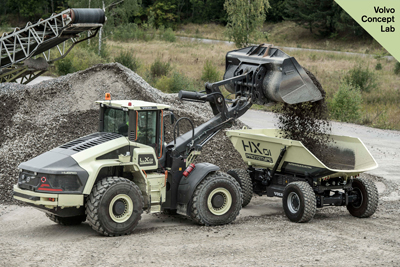Two new studies released this month paint a grim picture of the consequences of global warming. The papers published by scientists at the Universities of Colorado and Washington say that due to CO2 emissions, global temperature will likely increase more than 3.6°F by the end of the century, triggering a catastrophic rise in sea levels, super droughts, mass extinctions, and declining human health.

Volvo CE prototype hybrid wheel loader and electric hauler. Image courtesy of Volvo CE
Like countless previous reports, the authors conclude that the international community must make major and ambitious changes in climate and energy policies that limit carbon emissions. One central theme that is emerging is the move to eliminate IC engines from vehicles.
Consider that the U.K. and France have announced they will ban diesel and gas cars and vans in 2040, to tackle air pollution and global warming. More aggressively, Norway will push to limit sales of all fossil-fuel based cars by 2025, by instituting penalties on conventional cars and offering incentives to embrace alternatives. Other nations like Belgium, Japan, the Netherlands and Switzerland are contemplating phaseouts or watching developments closely. In addition, Volvo announced in July it will only sell battery-powered or hybrid cars from 2019 onwards, in what the company called an “historic end” to building models that only have internal-combustion engines.
It’s not just cars in the crosshairs. Volvo Construction Equipment has been working on electromobility and hybrid technology since 1998 and says electrification of off-road equipment is the long-term trend. That could definitely impact fluid-power markets. Hydraulics has always been regarded as outperforming electrics in terms of power density and ruggedness. But anyone who thinks mobile hydraulics is immune to inroads by competing technologies is kidding himself.
Last year Volvo CE introduced its experimental LX1 electric-hybrid wheel loader with an electric drive, battery energy storage system and a relatively small diesel engine. At Conexpo in March it presented the HX2 autonomous, battery-electric hauler with no diesel engine whatsoever. Two electric wheel motors eliminate less-efficient hydrostatics and a third electric motor powers a hydraulic pump to handle steering and actuate the dump cylinders. These machines are part of an electric-site research project in Sweden that predicts up to a 95% reduction in carbon emissions and 25% lower total costs in a quarrying operation.
And this May, the company unveiled a fully electric compact EX2 excavator that delivers zero emissions. The prototype replaces a combustion engine with two lithium ion-batteries, which store enough electric energy to run the machine for eight hours in intense digging applications. Electromechanical linear actuators that supplant the hydraulics are said to offer significantly higher efficiency, while removing the hydraulics and engine reduces cooling needs and makes for quieter operation.
“Volvo CE is committed to pushing boundaries and exploring the technology of the future,” said Jenny Elfsberg, director of emerging technologies at Volvo CE. Using electricity instead of diesel to power construction equipment has the potential to significantly reduce fuel consumption, CO2 emissions, environmental impact and cost-per-ton, she said. “The electrification of construction equipment will produce cleaner, quieter and more efficient machines—this represents the future of our industry.”
Filed Under: Mobile Hydraulic Tips